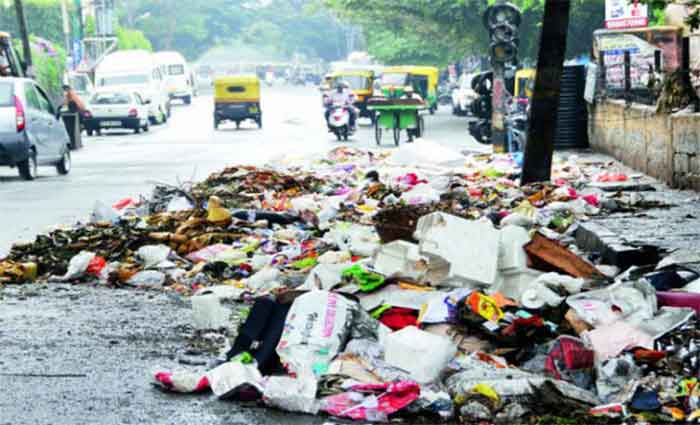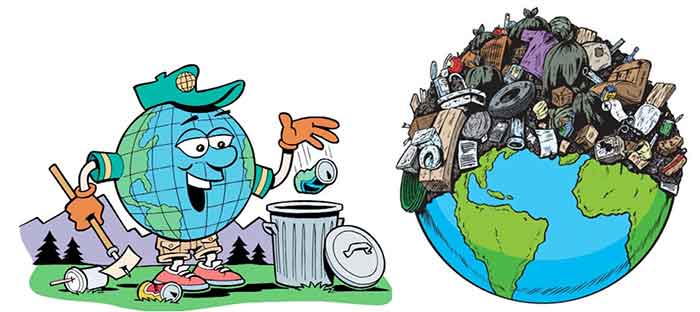
It is generally believed that the sanitary behaviour of Keralites when compared to other states in India is better. This may be partly true. The better sanitary behaviour is a naturally and culturally evolved artefact which has its foundation in the ecology of the region and especially the abundant availability of water. But this cultural artefact is being challenged and probably threatened due to introduction of new commercial culture especially plastics and other packaging material.
One of the serious problems which became explicitly visible during post-COVID days is that of such wastes. Huge quantity of wastes are piling up in common places in addition to many rivers. Heavy rains have given an indication that such piling up can lead to water logging and inundation in urban areas apart from serving as breeding sites of mosquitos and other vectors. One of the reasons for inundation which happened in many cities in Kerala during the rains is the blocking of channels and drains due to piles of accumulated wastes apart from unecological constructions.
It may not be an exaggeration to compare this with the ‘great stink’ of river Thames of London in 1858. The overpowering smell of stench and faeces from the river resulted in preventive actions in the House of Commons which included curtains of the Commons being soaked in chloride of lime in an effort to protect the ‘odour sensitivities’ of the MPs. Expectedly of the response of ruling classes all over the world, a bill was rushed through Parliament which became law in 18 days, to provide more money to construct a massive new sewer scheme for London, and to build the Embankment along the Thames in order to improve the sanitation. The emergency response also was due to cholera outbreaks also affecting the wealthy. Needless to say, it is possible to take preventive actions in Kerala before the situation affects the sensitivities of the wealthy and powerful.
The case of Chikungunya and Dengue
The Kerala situation may be a shade better as cholera outbreaks are impossible in the present context. However, Kerala had reported outbreaks of Chikungunya and Dengue in many districts since 2006. It had the first outbreak of Chikungunya during June-July 2006 along the coastal areas of Alappuzha, Kollam, and Trivandrum districts and again during May-August 2007 in Pathanamthitta, Kottayam and Idukki districts. As on October 28 2006, of the 13,92,027 cases reported from several parts of India, 70,731 suspected cases were from Kerala. Entomological surveys in worst affected areas in Kerala have showed high Ae. aegypti mosquito breeding in rubber plantations and in peri-domestic areas due to monsoon collection and fresh water logging. In May 2007, another outbreak occurred nearly in all the districts. During the survey it was found that, age seems to play a significant role in the manifestations of symptoms. Probably due to development of herd immunity, the Chikungunya outbreaks have reduced but could surface again due to waning immunity profile.
Dengue Fever (DF) which means “bone-breaking fever” (origin from Swahili word) was recorded during the Jin Dynasty (265–420 AD) in China. The first epidemic was reported in Asia, Africa and North America in the 1780s, shortly after Benjamin Rush identified and named the disease in 1779. The same Ae. aegypti mosquito is the vector for this fever as well. In India, it has been in existence since long and the first outbreak in epidemic form occurred in 1997 in North India. In Kerala, although periodic cases were reported since long, the first major outbreak occurred in 2017 when several districts were affected with around 20000 cases which dropped to around 4000 in 2019. The epidemic form of this viral infection is reported periodically in many parts of India. In Kerala, this may surface again and could be a major threat during the rainy seasons.
The outbreaks of Chikungunya and Dengue had inflicted considerable pain and misery among the people. It also caused substantial and unexpected local, regional and national financial burden towards healthcare. Many hospitals were ill-equipped to handle the burden of the disease. The unexpected rush of people and the un-preparedness of the health care systems had given a space for the quacks and unregistered practitioners in rural areas to expand their hold in the affected areas.
The perennial problem with respect to water management is the inconsistent supply which forces people to go back to unsafe sources. The use of sanitary latrines becomes unsafe during such periods. Evidently, infrastructural provision is not the only solution but sustainability is equally important.
One illustration of this experience despite the availability of water and personnel assistance is with respect to public toilets. For instance, visiting the stinking public toilets located in a number of public institutions such as Bus Stations, Railway Stations, Hotels and Offices apart from specific public comfort stations available in cities and towns is indeed an unpleasant experience. Preliminary exploratory investigations as part of a research project show that the quality of such facilities is extremely poor and the maintenance is shoddy although some of these facilities are inaugurated with much fanfare. There may be number of factors responsible for the poor state of such facilities; some of them being the behavioural patterns of the people who use them and also lack of maintenance by the persons who manage such facilities.
The Sustainable Development Goals (SDGs) mention the need for universal sanitation and improving environment health. Given the complexity of sanitary behaviour of the population, it is extremely important to understand the multi-disciplinary dimensions of toilets as well as general environmental sanitation. Constant monitoring and support to the population is essential than just provision to sustain the ‘claims of coverage’. An effective and focused environment health and sanitation policy which considers the multidimensional public health artefacts is needed to avoid the ‘great stink’ and outbreaks of various infections.
Professor K Rajasekharan Nayar is the Principal of Global Institute of Public Health, Ananthapuri Hospitals and Research Institutes, Thiruvananthapuram, Kerala












































